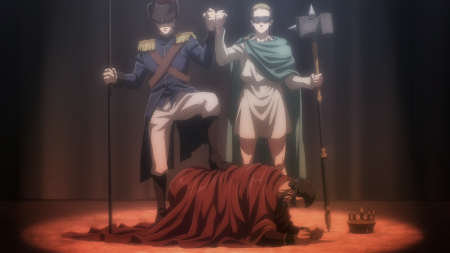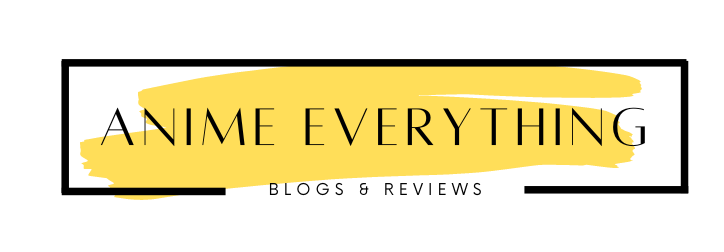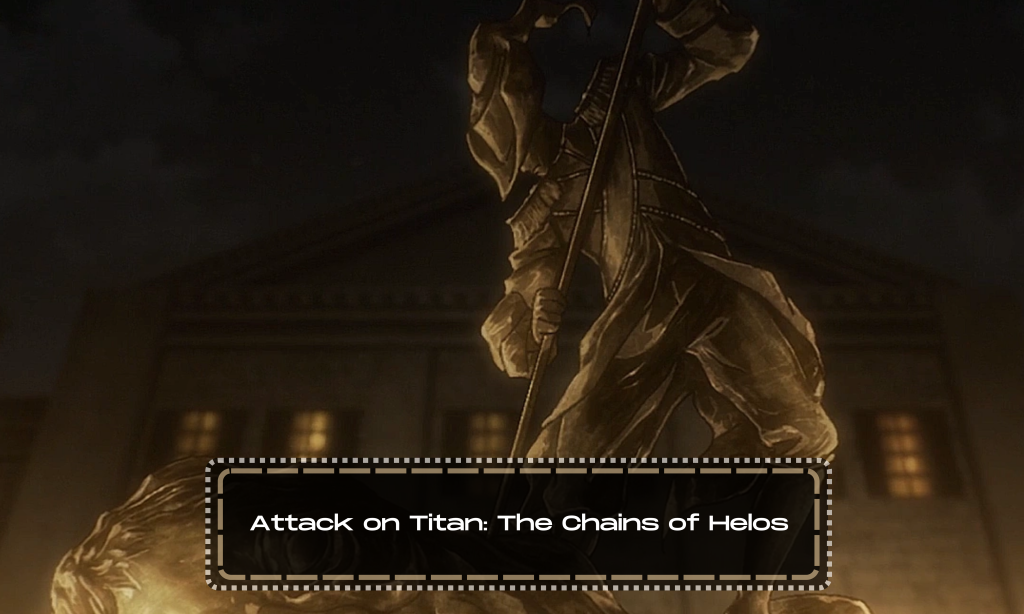Attack on Titan: The Chains of Helos
In the great nation of Marley, there once lived a man named Helos. Helos was said to be beautiful and strong, capable of shouldering all of the hopes and dreams of his people, and fully willing to put his life on the line to secure freedom for them. Though he was a mere human with no supernatural or extraordinary powers to boast of, Helos was profoundly courageous and took it upon himself to grasp victory in the Great Titan war against all odds.
After an arduous struggle, he manipulated the enemy and slayed the Devil of All Earth, the focal point of Marleyan pain and suffering and the crux of all of the evil that sprung from the oppressive force of Eldia. And this finally granted freedom for his formerly downtrodden kingdom and solidified his legacy as Marley’s savior.

Helos’ spirit lives on in the hearts of every young Marleyan spurred on to continue the fight for prosperity and liberation, and to this day, a statue of the great hero resides in Liberio as a monument to his beautiful spirit – A tribute to the man still celebrated as the ultimate ideal and the embodiment of Marley’s divine soul.
But is that celebration rooted in reality, or perceived necessity? The truth is, the entirety of this story is a fabrication. A lie conducted between the Tybur family and Karl Fritz to spark Eldia’s downfall and subsequent retreat into the walls of Paradis. And though the desired outcome was reached by all parties, the emotional and ideological embers of that myth still burn hot and bright.
And the most lamentable thing is that this propaganda is nothing new – it’s just been given a name and a fresh coat of paint. Because in essence, this has been the case for thousands of years, and though this story was moreso created to serve as an elegant cover up, in an abstract sense it isn’t one hundred percent false and it indirectly speaks of the origin of so much of this bloodshed.
It is not known and quite doubtful that the actual individual named Helos ever really existed. But the symbol of Helos is very much alive and well as the beating heart of conflict. He exists on every battlefield, in every nation, in the wide-eyed aspirations of every young child thrust into a world they know nothing of to suffer for the sins of their fathers.
He is everywhere. And he is bound in every way possible. Although originally a hero of Marleyan origin, Helos is very much a universal ideal and symbol representing the solitary person who bears it all – almost always a victim in one way or another, even if that victimhood is dwarfed by the impact of their other deeds.
And they take hold of this responsibility – maybe to return home, maybe to die a martyr, maybe to accomplish the same things that the original Helos did, or maybe to act as a focal point for hopes and pain in the service of others. In a period of time consumed by war, violence is unfortunately perpetuated as the norm, as an honour and endeavor in and of itself.
And the abstract idea of Helos is a disturbing tool that society glorifies to continue this chain. All alone in bearing the brunt of this, yet paradoxically, many in number across all war. And in reflection, Magath speaks plainly of the true nature of this icon. Willy, lamenting the lie of the legend and resolving to be this generation’s true hero simply because fate dictated that he must.
Erwin, who, while embodying a selfish dream, became the devil that his people needed despite his torment – ultimately sacrificing himself and countless other precious lives to fuel a faint glimmer of hope for those who would follow. Reiner, willed throughout his life by external factors from a punishingly young age to become the great hero and reverse fortunes that should never have been dependent on him in the first place.
Zeke Yeager, so broken that his solution to not being able to be free in this world is to prevent future generations from repeating this suffering through never being born in the first place. Eren Yeager, moving forward in a warped attempt to take everything back and be free, though not necessarily to be a hero – even if it means wielding an unthinkable evil.
But all the while bearing the brunt of this task all on his own. And through examining all of this, we see that there are as many Helos’ as there are links in a neverending chain. Often celebrated, the concept of Helos is the hero or focal point heralded as the means to stopping friction and conflict. But it’s also a falsity in this vein too, because there’s always another one needed.
Because any hero in this story is not a paragon of virtue and bravery and beauty. Because from another perspective, they are the opposite. A hero to some, a demon to others, causing nearly equal amounts of pain and agony for every person saved – the only exception being the Helos doomed to universally bear everything.
There are no winners here. This idea is romanticized propaganda perpetuating constant oppression. Just a target for the populace to place hopes on, someone to carry the burden, to bear it all.. sometimes sins, sometimes hate, sometimes misery and tragedy and pain. Helos is viewed as a path to salvation and liberation, but the ironic hypocrisy of this is clear.
Because Helos is a slave, and he should not be celebrated. He is simply a means to an end, a method of hoisting troubles elsewhere to be free of mind and capable of dreaming of peace. It never ends, and this perpetuation in itself means that the proposed spirit of Helos is empty and broken. Helos takes it all on and bears the burden in the hopes of ending conflict.
But the sad part is that this never comes to true fruition. Because every generation has a Helos on every side in every battle. While he exists through individuals, Helos isn’t a singular person; he is a symbol and an ideal, a glorification to be revived for as long as strife exists.
Helos is a necessity and Helos is in chains much more binding than any of the populace he wishes to liberate, and once he does his duty and fades into legend and folklore, it is never a calm and peace as envisioned, before another Helos, sometimes multiple, rise up to take his place. And everyone conveniently forgets that the previous time was supposed to be the last time.
Helos is the embodiment of the constant necessity for any given individual to throw their life away to rebel against this world. Helos is Erwin Smith. And Reiner. And Willy, and Kruger, and Gabi. Helos is Eren Yeager, the dictator of a plot spanning our entire story corrupted by a simple and unassuming dream of freedom.
And no one is truly free in this cycle. Helos is personified by the Marleyan Warriors who are celebrated as heroes for shortening their life span and dedicating their souls and hearts to giving their lives to atone for atrocities from generations past. With their families given a chance at a meaningful life, the pressure shifts to the one desperate to grant their loved ones some semblance of happiness in this world.
And likewise, those in Eldia forsake everything in the hopes that they can contribute to absolving the world from all of this. There are despairing saviors on all sides. But that desperation just begets more suffering until the simple cause and heart of the matter gets lost amidst the noise. As long as we are alive, we deserve a chance to live.
However, Helos is in chains, and it can’t go on like this. At this point, it is wholly unclear as to what could possibly free him. But on the path to this seemingly unattainable dream, Helos is the one who must first be saved and put to rest. We must do away with this symbol, this hero. Because his perpetuation is a big part of the tragedy at the root of the cause he fights for.
The world is just that cruel. Many thanks for reading.
That’s me, Andreea Blaga, author of the blog anime-everything.com. I work as a content creator in the US. I am also passionate about Japanese Anime.


Related post
Character Study: Korra and Aang’s Legacy
In the richly woven tapestry of the “Avatar” universe, the characters of Korra and Aang...
Jul
Islands of Wonder: Exploring the Unique Geography of One Piece
Enter the vibrant world of One Piece, a beloved manga and anime series created by...
Jul
Unveiling ‘The Eminence in Shadow’: A Dive into its Intriguing Premise
“The Eminence in Shadow” is a light novel series written by Daisuke Aizawa and illustrated...
Jul
Dragon Ball Z: A Cultural Phenomenon Through the Ages
Since its debut in 1989, “Dragon Ball Z” has become a cultural phenomenon that transcends...
Jul
Unleashing the Chainsaw: A Deep Dive into Chainsaw Man’s Gripping Plot
In the realm of dark fantasy manga, few series have captivated readers quite like Tatsuki...
Jul
Aang’s Journey: From Reluctant Hero to Avatar of Peace
In the world of animated series, few have captured the hearts and minds of viewers...
Jul